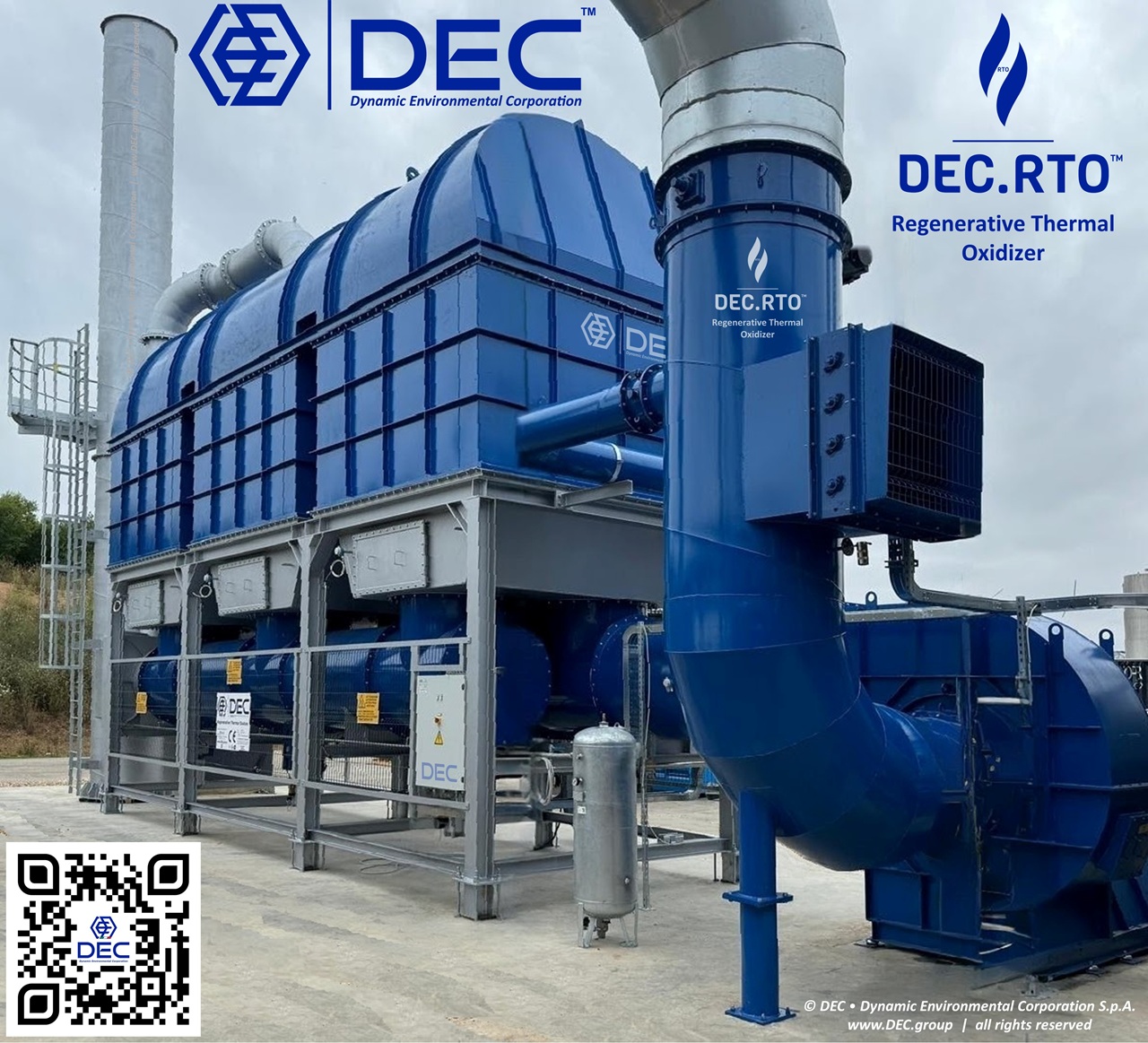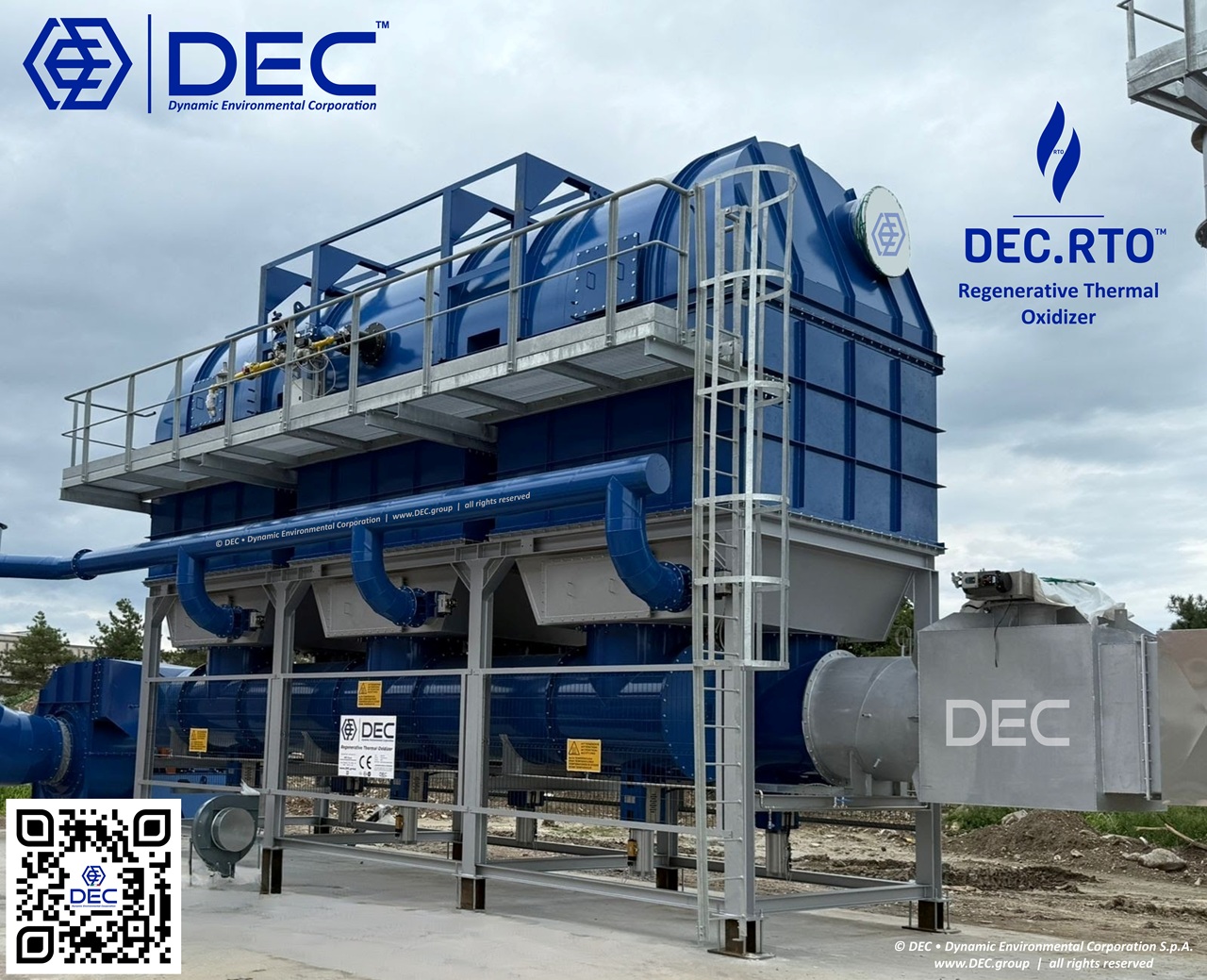
Regenerative Thermal Oxidizers 🔥 DEC.RTO™
VOC emission control
Regenerative Thermal Oxidizers (DEC.RTO™) are a specific configuration of a thermal oxidizer system (XTO™): in the RTO, multiple towers (or chambers) are used to achieve efficient and effective air pollution control.
Optimizing VOC capture in production benefits both your bottom line through reduced energy costs and your workforce through improved safety. A key strategy for minimizing operating expenses is the autothermal operation of the thermal oxidizer. Our systems are designed to primarily use natural gas for initial startup; once the temperature is sufficient, the inherent thermal energy from the VOCs sustains the combustion process, drastically reducing or eliminating the need for further gas consumption.

DEC Regenerative Afterburners (DEC.RTO™) enhance natural gas-free autothermal operation by efficiently preheating exhaust air with (ceramic heat accumulators (DEC.CCH™). High VOC loads can even generate surplus energy that can be repurposed as process heat (DEC.WHR™).
By efficiently capturing exhaust air, VOCs become a valuable energy resource. This includes optimizing collection at printing presses, coating lines, and drying ovens. The Integrated Suction Control (DEC.ISC™), a smart management system across the different production lines, boosts continuous autothermal exhaust air purification, even during changeovers and with varied product ranges. Moreover, a well-planned fresh air intake, to capture fugitive emissions, can improve the working environment for your employees.

how it works? • DEC.RTO™
Regenerative Thermal Oxidizers (RTOs) typically incorporate a minimum of two (optimally three or more) parallel heat exchange beds (towers) to facilitate continuous VOC abatement. The process involves the cyclical diversion of the exhaust gas stream between these beds. One (or more) bed serves to preheat the incoming solvent-laden air (SLA), while the other(s) undergo heat recovery in anticipation of the next exhaust gas flow reversal.

This alternating process allows for energy recovery within the DEC.RTO™ system: the hot exhaust gases leaving the combustion chamber are passed through a ceramic heat exchanger, known as the "regenerator", in the tower undergoing the regeneration cycle. The regenerator absorbs the heat from the exhaust gases and stores it. During the next cycle, the stored heat is transferred to the incoming cold exhaust gases, reducing the energy consumption of the system.
The use of multiple towers in the DEC.RTO™ system provides several advantages, including improved operational efficiency, reduced energy consumption, and continuous operation. It allows for a consistent and reliable treatment of industrial exhaust gases while optimizing the use of energy resources.
By cycling the exhaust gas through the heat exchange beds, these RTOs achieve unparalleled energy efficiency and minimize fuel usage, in some cases even enabling fully self-sustaining (autothermal) operation.
oxidation reaction • DEC.RTO™
The oxidation reaction is:
VOCs (CxHyOz) + O2 + thermal energy = CO2 + H2O + (HEAT)
The heat is usually recovered to pre-heat the SLA stream, in order to save on "thermal energy" (provided through gas CH4 - methane); if producing extra heat through oxidation of solvents, an energy recovery system shall be foreseen (typical applications are ranging from heating up air for dryers, steam production, heat tranfer fluid heating, water heating - industrial or sanitary, etc.).

advantages • DEC.RTO™
In a regenerative thermal oxidizer (RTO) with multiple towers, the VOCs are oxidized in the combustion chamber. The hot gas released from the combustion chamber contains thermal energy. This thermal energy is accumulated through the ceramic media bed in one tower. The hot gas then cools down as it exchanges thermal energy with the ceramic media. The cooled gas is then discharged through the stack.
The process of accumulating and exchanging thermal energy in the ceramic media bed is called regenerative: this process allows the RTO to operate at a high efficiency, while also reducing the amount of energy required to heat the incoming gas.
Thanks to the specifically designed switching valves, the flow is alternatively reversed: thermal energy is recovered and the flow, in the following cycle, is pre-heated; this cycle is efficiently reducing the auxiliary support fuel requirement, with self-sustaining operation (with no auxiliary support fuel usage) even at low concentrations, thus representing an operational cost reduction.
RTOs with multiple towers can operate at a higher efficiency than Direct Thermal Oxidizers (DTO™): the regenerative process allows the RTO to recover heat from the outgoing gas, which can then be used to pre-heat the incoming gas, resulting in lower fuel consumptions.

Hot Gas Bypass module | DEC.HGB™ • DEC.RTO™
In case of peaks of concentration, in order for the RTO to correctly perform its duties, to prevent overheating (or oxidation to occur in the ceramic media), the system can be equipped of an automatic hot-gas bypass. The DEC.HGB™ diverts a portion of the hot gases directly from the combustion chamber, bypassing the ceramic media beds.
As the concentration of volatile organic compounds (VOCs) in the incoming stream increases, the combustion chamber temperature rises due to the additional heat generated by the combustion process. When the temperature reaches a pre-set safety limit, the DEC.HGB™ module is automatically enabled, allowing a portion of the hot exhaust gases, to directly bypass the ceramic media beds and exit to the exhaust stack (FGS). By diverting the hot gases, the DEC.HGB™ module safeguards the ceramic media from exposure to excessively high temperatures. This is crucial because the media plays a vital role in preheating the incoming air stream and maintaining the overall efficiency of the RTO.
The DEC.HGB™ components directly exposed to the high-temperature exhaust gases (around 900°C) are typically constructed from special high-grade materials like Stainless Steel or Inconel.
In essence, the DEC.HGB™ module acts as a safety mechanism and a way to optimize RTO performance. It prevents damage to the ceramic media while ensuring the RTO can continue to function effectively even during abnormal or unexpected spikes in VOC concentration.
Waste Heat Recovery module | DEC.WHR™ • DEC.RTO™
When the process conditions allows (e.g. when VOC in the emission stream reaches higher than normal), and the DEC.HGB™ module is installed, the diverted hot stream, can be used for beneficial purposes. DEC.WHR™ module acts as a secondary heat recovery.
Waste To Energy module | DEC.WTE™ • DEC.RTO™
Thanks to the optional DEC.WTE™module, by utilizing the solvent waste as "alternative" fuel in the RTO, the system requires less external fuel to maintain the oxidation temperature. Instead of paying for solvent waste disposal, the facility can utilize it as a fuel source, potentially creating a cost-saving opportunity.
Modular Oxidizers • DEC.RTO_SMS™
Regenerative Thermal Oxidizers (DEC.RTO_SMS™) are based on the award winning DEC modular platform (skid mounted, SMS™): a compact configuration of a Regenerative Thermal Oxidizer (DEC.RTO_CBS™). Unlike larger traditional RTOs requiring extensive on-site assembly, the compact RTO arrives fully integrated and rigorously tested, significantly reducing installation time and costs.
Flameless Oxidation • DEC.e-RTO™
The flameless DEC.e-RTO™ operates on a similar principle to its combustion-based counterpart, but without the use of an open flame and auxiliary support fuel. Instead, electric heating elements provide the thermal auxiliary energy required to oxidize contaminants (VOCs).

thermal oxidation | incinerators • GHG and by-products
Whenever you have to face a non-recoverable stream of VOCs, a XTO™ • thermal oxidizer could be the solution: sometimes the VOC stream composition may result too complex to be recovered or the quantity of solvents is not interesting to go for a SRU™ • solvent recovery units.
An oxidizer is handling the transformation of the pollutant(s) into different products, with a reduced environmental impact. However, it is important to consider the resulting GHG emissions, when selecting a VOC oxidizer; the amount of GHGs generated by a thermal oxidizer depends on the type of VOCs being treated, its quantity, the needed quantity of fuel to be added for sustaining the oxidation reaction and the selected oxidizer process configuration.
Any oxidizer will have to deal with all or most of the following issues:
These emissions contribute to climate change and should be taken into account when assessing the overall environmental impact of the system.
As mentioned earlier, oxidizers typically require a significant amount of energy to operate: if this energy comes from non-renewable or carbon-intensive sources, it will dramatically contribute to environmental degradation and offset any of the potential benefits of VOC emission reduction.
regenerative thermal oxidation | LTKW
Optimize your industrial operations with cutting-edge Regenerative Thermal Oxidizer (RTO) technology, the gold standard for efficient VOC emission control. Discover the significant benefits of a regenerative thermal oxidizer over traditional systems, achieving superior destruction efficiency, especially for high VOC concentrations. Learn how RTOs minimize energy consumption and maximize heat recovery, leading to substantial operational cost savings. We provide comprehensive solutions, from initial sizing for large industrial facilities to detailed installation cost breakdowns, ensuring your compliance with stringent environmental regulations. Explore our range of RTOs, designed for diverse applications, including paint booths, chemical processing plants, and printing industries, and enhance your environmental stewardship.
Navigating the complexities of industrial VOC abatement? We offer expert insights into how a regenerative thermal oxidizer reduces VOC emissions, alongside practical information like maintenance checklists and troubleshooting common problems. For those seeking to invest, we provide cost of installing a regenerative thermal oxidizer for a paint booth, and used regenerative thermal oxidizer for sale with warranty. We also cover specific industry needs, like the best regenerative thermal oxidizer for printing industry VOC control, and solutions for pharmaceutical, food processing, ethanol, fiberglass, adhesive, resin, and coating line applications. Understand the technical aspects, including RTO design and engineering considerations, refractory material selection, burner types, and control system upgrades. Learn about heat recovery systems, air flow control, performance monitoring, and operational cost analysis. We also address specialized concerns like solvent recovery, fume incineration, and volatile hazardous air pollutants (VHAP) control, including applications in hazardous waste treatment plants and large volume air flow VOC destruction.
contact DEC today!
Join us on this journey towards a greener future. Contact us and experience the excellence of DEC's VOC abatement systems and witness firsthand how our solutions can drive your business forward while preserving the planet we call home.
thermal oxidation | incinerators • greenwashing
Greenwashing will occur when a company promotes an oxidizer as an environmentally friendly or sustainable technology for VOC emissions control, while neglecting to address other significant negative aspects of its environmental impact, such as greenhouse gas (GHG) emissions and harmful by-products.
Greenwashing can happen when a company portrays an oxidizer as a comprehensive and eco-friendly solution to VOC emissions, creating the perception that it is a sustainable option without considering the complete environmental picture. While oxidizers can help reduce VOC emissions, they can have negative consequences that should not be overlooked.
To avoid greenwashing, companies shall provide transparent and comprehensive information about the environmental impact of their VOC emission control systems: this includes addressing greenhouse gas (GHG) emissions, harmful by-products, and the energy efficiency of the system. By doing so, companies can ensure that consumers have an accurate understanding of the technology's environmental implications and make informed decisions.
